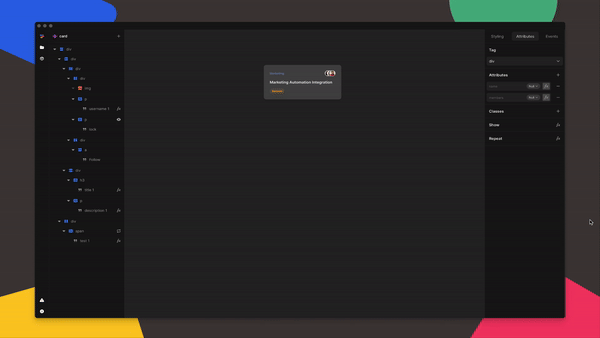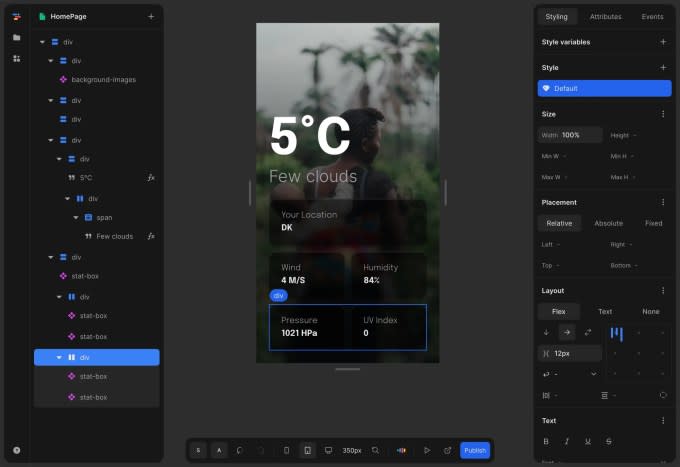Toddle wants to 'change how we build software' with a collaborative visual web app builder
The technology world has long promised to democratize software development through "visual" tools that help non-coders build digital products. In years gone by, this might've been something like Microsoft's Visual Basic for Applications (VBA) or Dreamweaver, and in recent times we've seen a slew of no-code and low-code startups raise bucket loads of cash to broaden access to the software development process.
It's against this backdrop that Danish startup Toddle has thrown its hat into the visual development ring: It has launched a no-code platform designed as a full-featured alternative to Javascript frameworks, replete with real-time collaboration, version control and hosting.
Ultimately, the company says it wants to "change how we build software."

A crowded space
Startups including Bubble, Flutterflow, Builder, Softr, Framer, Webflow and countless others have raised hefty amounts — often at billion-dollar valuations — for their various interpretations of what a no-code development platform should look like. While not all of these are targeted at the same markets, they are powered by similar ideals: Anyone in a company should be able to dabble in software development, regardless of their coding prowess.
Founded in 2022, Toddle is the handiwork of CEO Andreas Møller and CDO Kasper Svenning. The co-founders set out to build a platform that gives designers direct access to a live codebase through a visual editing interface, enabling them to make UI (user interface) and UX (user experience) changes that reflect immediately in the underlying code framework.

The founders are pitching Toddle as a tool capable of replicating the power of languages like React, but in visual form. Møller envisages design and developer teams using Toddle for building fully-featured SaaS apps — similar to how a developer might use Figma for designing their digital products; Webflow for creating marketing websites; Glide for a bit of prototyping; and Bubble for extensive testing through minimal viable products (MVPs).
"Basically any kind of SaaS application where you need advanced functionality," Møller told TechCrunch. "Can it be built in React? [Then] it can be built in Toddle."
The idea is that developers and designers can work from the same page in the same "language," without having to flit between different environments. Every component created in Toddle can be stored as packages and reused across projects, and version control lets developers revisit old versions of components or apps as needed.
So while designers may work on tweaking the interface, marketers can edit content, and developers can focus on the core logic of building the app without having to be enlisted for every button style-change. Toddle is effectively the "translation layer" that maps visual edits to the corresponding front-end framework and CSS methodology — everything is synchronized both visually and programmatically.
It's worth noting that Toddle isn't a full-stack web app builder — it doesn't have a built-in database, for example. An all-in-one front- and back-end builder might make sense in some instances (e.g., for prototypes or simple applications), but Møller considers that those building complex applications will have evolving requirements, so it doesn't make sense to lock them in with Toddle. "One-size-fits-all technologies always become one-size-fits-none over time," he wrote in a blog post explaining the rationale.
Instead, for back-end functionality such as databases and authentication, Toddle works with whatever systems the developer wants to use. The company offers a library of integrations including Xano, Supabase, Airtable, GraphQL, Stripe (for payments), and even AI models from the likes of OpenAI and Hugging Face.
In terms of pricing, Toddle operates a freemium model, with its free tier offering most of the building blocks needed to start building web apps. However, a major caveat here is that this only applies to open source projects, and they must be hosted on Toddle's own domain.
Still, if nothing else, it's a good way to sample what Toddle can do. Users can pay to unlock additional storage, access custom domains, and remove all the Toddle branding.
"Everything you can build in Toddle, you can build in the free tier," Møller said. "That's important to us because we want to change the way that software is developed. We need to make it accessible to everyone as long as they have a computer."
The open source factor
The two-year-old company claims to have 9,000 individual users, and that it sees up to 80 new signups each day and around 60 paying users. It's a modest start for sure, but Toddle on Tuesday said it has raised $4.3 million in seed funding as it gears up to open-source the bulk of its platform. The company plans to release the language and runtime components of its platform under a permissive Apache 2.0 license, and plans to also make its editor open source at a later stage.
The "language" in this context refers to the editor's output — the raw code that Toddle sends to the AST (abstract syntax tree), which is then translated to machine-readable binary code. The runtime refers to the "interpreter" that serves the necessary components and services required to execute a program.
The long and short of this is that developers will eventually be able to self-host apps built in Toddle without having to use the platform itself, and they will be able to modify and enhance the language for their apps. Møller says the company expects to open source these various elements starting this year and running into 2025.
"We have some work to do to decouple the open source code," Møller said. "It will happen in stages."
Toddle's seed round was led by Finnish VC firm Inventure. Lifeline Ventures, PSV, and a handful of angel investors, including Typeform co-founder David Okuniev, also participated.

